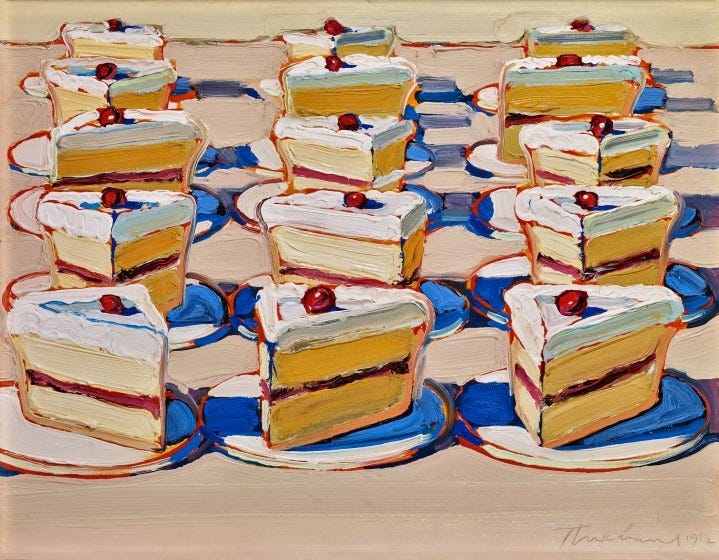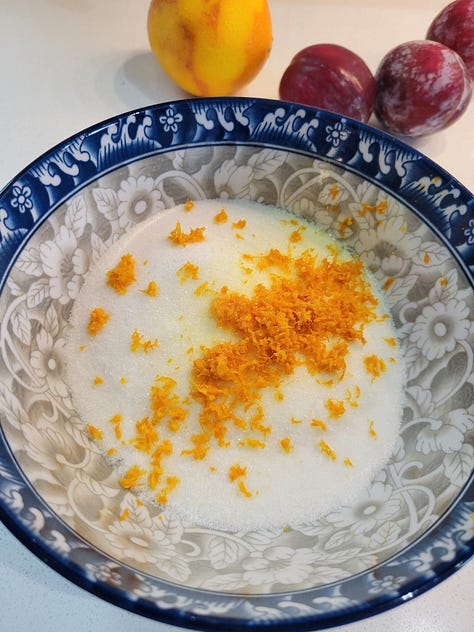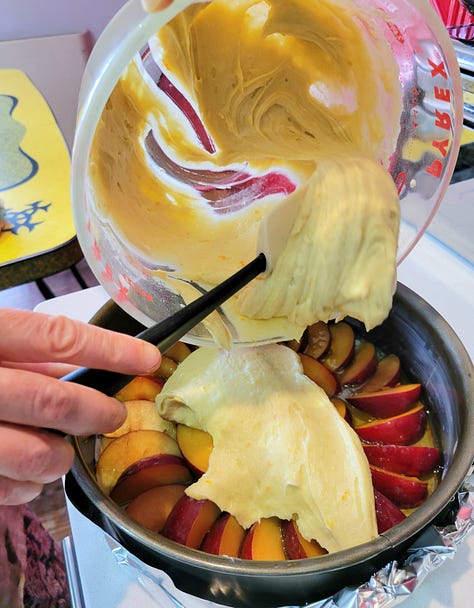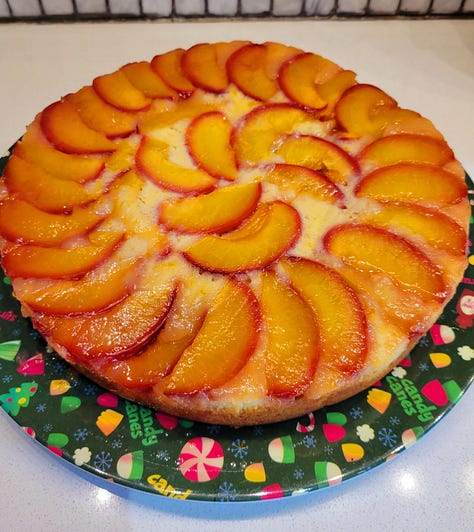
On Wednesday, I had a private painting lesson with a wonderful student. It was one of those days I wish I had a recording—I was on fire, saying things out loud that usually stay stuck as intuitive feelings. I don’t know why it all came so easily, but it did. As I talked, I kept thinking, This is a good way to explain this. I want to remember it.
This student is someone I enjoy working with. David asks great questions that get me thinking about art—and making art—through a new lens. We always have a good conversation, and today was no exception. One thing we spent a lot of time on was how to handle the shadow under the plate and the edge of the plate itself. I explained that some edges benefit from being blurred or broken, while others should remain crisp and sharp. I mentioned that I like to approach the shadow under the plate much like Wayne Thiebaud, with a thick brushstroke that almost looks like icing, defining the shape using the color of the table underneath. That’s my personal style.
I also showed him a Cézanne painting where the edge of the plate is defined with both bold, crisp lines and softer, broken lines. That’s the beauty of it—there are choices to be made. How do you want to describe the transition from shadow to light? The kind of mark you make is a stylistic decision that evolves as you learn what feels natural to you.
I emphasized that style develops in how you make marks on the surface. For example, do you carve out an object by painting the negative space around it? Or do you define it by painting the object’s local color, then developing its light and dark sides? If there’s texture involved, that, too, plays a role in how you build your own visual language. This isn't just about recreating what you see; it’s about revealing it in a way that’s uniquely yours.
Lately, I’ve been thinking about the difference between a picture maker and an artist—and how that connects to style.
A picture maker is trained in craft. They know how to draw, how to paint, how materials work. They understand anatomy, value, and color theory. They can work in any medium, emulate any style, and support someone else’s vision.
An artist, though, brings their own vision. It’s personal. In today’s culture, that personal vision—the artist—is more celebrated. With photography and video, we don’t need picture makers the same way. We don’t need someone to paint portraits or document cityscapes or wartime scenes for newspapers. That work used to be necessary and now it is not.
As I’ve been reading older books and looking at art made before photography, I keep coming back to the question of how we render images. When Philadephia’’s University of the Arts abruptly closed last spring, artist Doug Randall said that UArts and the Pennsylvania Academy of the Fine Arts forgot they were vocational schools. They tried to become fine art universities. There’s a false idea that vocational training is lesser. But it’s not. It teaches real, useful skills for work as mechanics, carpenters, potters, glassmakers, garment makers, sign painters—and once upon a time, picture makers.
Now, most art schools emphasize expression and personal voice but many skip foundational training. I’m grateful for the traditional, vocational-style training I got. It wasn’t about personal expression. It was: This is how you draw a figure. This is how etching works. This is what is in the paint. That kind of education means you can do anything. Style can come later.
Style, I think, is about picking things up and letting other things go. Learning something new often means replacing an old habit. A new technique might mean giving up a favorite brush, color, or approach. If you are simplifying, you are telling the story of a form in a new way. If you are adding detail, you are giving space for something to fully unfold.
Style also comes from drawing a lot. From understanding your materials. From knowing how paint moves, how a tool carves, how the image reveals itself. It comes from what draws you in—your subjects, how you see space, how you imagine form.
And it comes from editing. From asking: Does this say what I meant it to say? Do I need more lines? Fewer marks? A different color?
David and I talked about editing and adjusting a composition when it doesn’t work. Something might look fine in real life, but in two-dimensional space, it feels off. A line might create tension or a dead zone—a part of the painting where the eye stops moving. So how do you fix it? You can’t just copy what you see. You have to make the painting work.
I set up the still life —plums, pears, and a jam pot. It was inspired by a Cézanne painting at the Barnes Foundation I couldn’t stop thinking about. I liked the green pears next to the purple plums. The jam pot was kind of cute. I wanted peaches, but they weren’t in season.

Still, why those objects? Why that arrangement? I’m not sure. It’s what drew me in. And that’s the question David keeps asking: What’s the intention?
He’s been trying to develop his painting style. A few weeks ago, he said, “I wish I could paint more like how I draw.” That stuck with me. His drawings emerge from the paper—he pulls the form out with his marks. I’ve been thinking about how to help him do that with paint. Instead of sticking things to the canvas—here’s a plum, here’s an apple—I want him to discover the image through painting. Let it develop. Let it reveal itself.
Not attacking the surface, but listening to it. Observing and responding. Pulling the image forward, one mark at a time.
Enjoyed this post? Leave a comment—I’d love to hear what resonated with you. If you know someone who might like it too, please forward it or share the link.
Hestia’s Plum and Orange Cake



Ingredients:
3 to 4 ripe plums, sliced into ¼-inch wedges
½ cup plain or Greek yogurt
½ cup (1 stick) unsalted butter, at room temperature
1 large orange (zest and juice)
1½ cups granulated sugar
3 large eggs
1 teaspoon vanilla extract
2 teaspoons baking powder
½ teaspoon salt
1½ cups all-purpose flour
1 to 2 tablespoons water, if needed
Instructions:
Preheat the oven to 350°F. Grease a 9-inch springform pan and line the bottom with parchment paper. Grease the parchment as well.
In a medium bowl, combine the sugar and orange zest. Use your fingers or a fork to mangle the zest into the sugar until it's fragrant, slightly clumpy, and orange-colored. Measure out ½ cup of this zesty sugar and place it in a small saucepan with a pinch of salt.
Juice the orange into a measuring cup. You need ⅓ cup of liquid. If you don’t have enough juice, add 1 to 2 tablespoons of water to reach ⅓ cup. Add the liquid to the saucepan with the sugar and bring to a simmer. Cook until slightly thickened, then remove from heat and let cool slightly.
Arrange the sliced plums on the bottom of the prepared pan. Pour the orange syrup evenly over the fruit.
In a mixing bowl, beat the remaining zesty sugar with the butter until light and fluffy. Add the eggs one at a time, beating well after each. Mix in the yogurt and vanilla.
Add the baking powder, salt, and flour. Mix until just combined. Spoon the batter over the plums and smooth the top.
Bake for 55 to 60 minutes, or until a toothpick inserted into the center comes out clean.
Let the cake cool in the pan. Run a knife or offset spatula around the edge to loosen. Place a serving plate over the pan and carefully flip the cake (whisper a prayer to the kitchen goddess that the cake releases in one piece). Remove the sides of the springform and peel away the parchment.
If you enjoyed this post and want to support my work, feel free to leave a tip! Your support helps me continue sharing my art process, insights, and recipes, without the commitment of subscribing.
Finding Creative Ground is a reader-supported publication. To receive new posts and support my work, consider becoming a free or paid subscriber.





“Not attacking the surface, but listening to it. Observing and responding.
Pulling the image forward, one mark at a time.” This is everything. I’m an abstract artist but it is the same ethos. The paintings where I am “attacking” feel dead. It is when I slow down and “talk” to the canvas is when it comes alive.
I loved reading your piece about picture maker versus artist - and how art schools today do not teach the basics… I live in England and art schools today teach very little…in fact if a student arrives with some natural talent, they quickly squash their confidence and make them adopt “conceptual art” whilst ignoring basic drawing and observational skills. I attended Art college many years ago and am continually experimenting with new techniques from printing and painting to mixed media and thread art … thanks again for your thoughtful writing xx